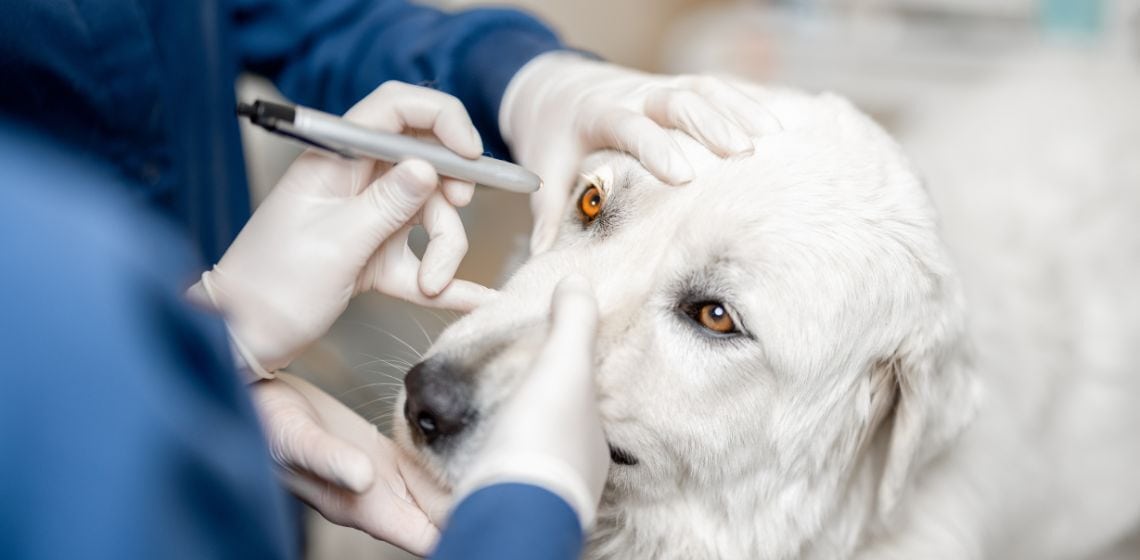Table of Contents
What is Glaucoma in Dogs?
Glaucoma is a disease leading to increased pressure within the eye (intraocular pressure or IOP). Glaucoma may be inherited or occur as the result of another eye disease. While there are several possible causes of glaucoma in dogs, all can lead to pain and blindness.
Glaucoma is a medical emergency, as blindness will occur quickly without treatment. Glaucoma in puppies can occur, but it is more common in middle age dogs. Depending on the underlying cause, glaucoma may require lifelong treatment, and in some cases, removal of the eye is recommended.
Just like people, dogs’ eyes contain a clear fluid called aqueous humor. This fluid is produced by the ciliary body and provides nutrients and oxygen to structures in the eye. Aqueous humor is constantly circulating in the eye. After it has supplied nutrients it is drained between the cornea and the iris at an area known as the iridocorneal angle (drainage angle).
In a healthy eye, there is a delicate balance between the production and drainage of aqueous humor. If drainage of this fluid cannot keep up with production, intraocular pressure increases and glaucoma develops.
Blindness occurs due to damage to the retina and optic nerve from this increased pressure. When IOP is elevated long-term it is more likely to result in irreversible blindness. Therefore, prompt recognition and treatment are essential in managing glaucoma.
Types of Glaucoma in Dogs
Glaucoma is caused by a problem with the drainage of aqueous humor leading to increased intraocular pressure in the eye. The causes of glaucoma can be classified as primary or secondary.
- Primary glaucoma occurs in an otherwise “healthy eye”
- Secondary glaucoma is caused by another disease process in the eye.
Additionally, glaucoma can be classified based on the appearance of the drainage angle, including open-angle glaucoma or closed-angle glaucoma.
- Open-angle glaucoma causes a slow and progressive loss of vision over time.
- Closed-angle glaucoma causes a sudden increase in intraocular pressure, acute loss of vision, pain, and redness.
Lastly, when glaucoma is diagnosed, it may either be acute (occurring within the last 12-24 hours) or chronic (IOP has been elevated for several days or longer). Dogs with chronic glaucoma are unlikely to regain their vision.
These classifications of glaucoma can occur in any combination and help your vet determine the best treatment recommendations and prognosis for your pup.
What Causes Glaucoma in Dogs?
Primary Glaucoma
Primary glaucoma is caused by inherited abnormalities of the iridocorneal angle. As this is a genetic condition, it is more common in purebred dogs. Certain breeds of dog are more commonly affected, including the Cocker Spaniel, Beagle, Basset, Akita, Chow Chow, Samoyed, Bouvier de Flandres, Shih Tzu, and Chinese Shar Pei. Eventually, both eyes will become affected, although there may be years in between.
Primary Open-Angle Glaucoma (POGA)
Primary open-angle glaucoma is an inherited condition that causes a gradual increase in intraocular pressure and a slow loss of vision over time (months to years).
Primary Closed-Angle Glaucoma (Goniodysgenesis)
Dogs with this inherited risk factor are likely to develop closed-angle glaucoma in the future. These dogs can be identified with DNA testing and should have regular eye exams. When glaucoma occurs, it does so suddenly.
Secondary Glaucoma
Secondary glaucoma occurs due to another disease process in the eye. It is more common in dogs than primary glaucoma and may affect one or both eyes. Common underlying causes include:
- Uveitis: Inflammation of the interior of the eye (uveitis) can lead to scar tissue or debris that blocks the drainage angle. Uveitis can occur due to a variety of underlying causes, such as infections, immune-mediated disease, diabetes, cancer, etc.
- Lens luxation: The lens normally sits behind the iris. If it becomes displaced, it can physically block the drainage angle.
- Tumors: Tumors in the eye can also physically block the drainage angle.
- Cataracts: Cataracts affect the lens of the eye, and can cause inflammation and debris that interfere with drainage.
- Intraocular bleeding: A blood clot can also interfere with drainage.
Glaucoma Symptoms in Dogs
Symptoms of glaucoma may be acute or develop more slowly over time. Additionally, clinical signs may be difficult to identify until the disease has significantly progressed.
- Eye pain: Your dog may squint, rub/paw at their face, shy away from touch, and avoid light.
- Swelling or bulging of the eye
- Clear discharge from the eye
- Redness of the sclera (white of the eye) or a bloodshot eye
- Blue, cloudy, or hazy appearance to the eye
- Blindness or decreased vision: bumping into things, walking slowly, etc.
- Changes in pupil size and response to light
- Systemic signs such as decreased appetite and lethargy
How to Diagnose Glaucoma in Dogs
Your vet will diagnose glaucoma based on history, physical exam, eye exam, and diagnostic testing. You may also be referred to a veterinary ophthalmologist to help manage this condition.
- Tonometry: Intraocular pressure can be measured with a tool known as a tonometer. Your vet will likely apply anesthetic drops to the eyes and then gently touch the surface of the eye multiple times with a Tono-pen. There are also other types of tonometers that do not touch the eye to measure pressure. Your vet will measure and compare the pressures in both eyes. Normal IOP range is 15-25 mmHg. If IOP is elevated it is indicative of glaucoma. Additionally, a difference of more than 10 mmHG in IOP between both eyes may also indicate glaucoma. IOP may be decreased in eye conditions such as uveitis.
- Gonioscopy: An ophthalmologist can use a special lens to visualize the iridocorneal angle.
- Other: An ophthalmologist may also perform other types of testing, such as an ultrasound, to further evaluate the eyes.
Glaucoma in Dogs Treatment
Intraocular pressure must be lowered as soon as possible to decrease pain and prevent further irreversible vision loss. Medical and surgical options are available. Secondary glaucoma also requires diagnosing and treating the underlying cause. In some cases, removal of the eye may be the best course of treatment.
- Pain medications: Analgesics are critical to helping manage the pain associated with this condition.
- Medications to lower IOP: Many medications are available to help decrease fluid production and promote drainage to lower the pressures within the eye. Commonly used medications include osmotic diuretics, prostoglandin analogues (Latanaprost, travaprost), carbonic anhydrase inhibitors (dorzolamide, brinzolamide), topical miotics (pilocarpine), and beta blockers (timolol, levobunolol, betaxolol). Many of these medications are topical and must be applied to the eye two or three times per day. Some are oral medications. Some of these medications may not be safe in dogs with specific underlying conditions; therefore treatment may vary from dog to dog.
- Treatment of underlying eye disease: If your dog has secondary glaucoma your vet will also need to address the underlying eye disease that has caused glaucoma.
- Long-term management: Primary glaucoma requires life-long treatment to manage the elevated pressures in the eye. Your vet will recommend frequent follow-ups and a long-term management plan based on the type and cause of your dog’s glaucoma.
- Surgery: In some cases, surgery may be successful at resolving the underlying cause of secondary glaucoma, such as cataracts or lens luxation. An ophthalmologist can also perform specialized surgery to help decrease IOP, often in conjunction with medications. Eventually, many dogs with glaucoma end up having an enucleation surgery to remove the affected eye. If your dog’s eye is blind and painful, removal is the best option.
Caring for a Blind Pet
Glaucoma is a serious condition. Forty percent of dogs with glaucoma will become blind in the affected eye within one year, regardless of treatment. If your furry family member loses their vision to glaucoma, they can still have an enjoyable and excellent quality of life. It may be an adjustment for both of you, but there are many tips available on caring for a blind pet.
Yes, dogs can live with glaucoma, however, the condition can cause blindness and extreme pain if left untreated. Most dogs with glaucoma will require life-long treatment. Due to the painful nature of the condition, removal of the eye may be recommended.
Yes, the sudden onset of glaucoma in dogs is extremely painful and requires emergent veterinary treatment to reduce the intraocular pressure within the eye and try to save the vision. Chronic conditions are also painful due to a prolonged increase in IOP. Dogs with eye pain may squint, rub/paw at their eyes, shy away from touch, and avoid light. Pain medications are an important part of managing glaucoma in dogs.
Early signs of glaucoma can be difficult to identify but may include squinting, a bloodshot eye, cloudy cornea, and a dilated pupil. Glaucoma may also occur suddenly and cause an acute increase in intraocular pressure, pain, redness, and vision changes. Eye issues in dogs can be painful and progress quickly; therefore if you notice any changes to your dog’s eyes, it is important to see a vet as soon as possible.

Liza is a veterinarian who graduated from MSU CVM in 2013 and spent five years working in small animal practice. She loved working with dogs and cats and educating owners on all aspects of veterinary medicine, especially animal behavior and dermatology. She has since transitioned to remote work to be able to spend more time at home with her husband, two young kids, and two cats. She is thrilled to be able to combine her passions for veterinary medicine and writing. She is licensed as a veterinarian in Washington State.








